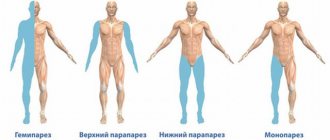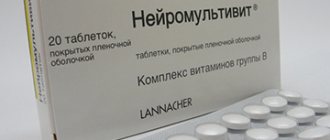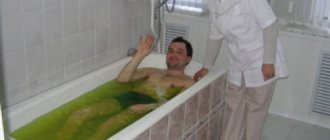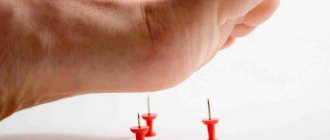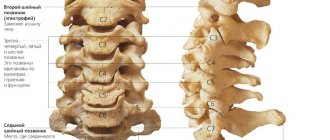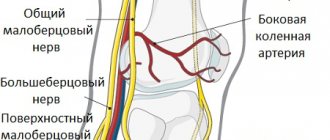The causes of polyneuropathy are very different, but in general, the functioning of many individual nerves and the peripheral nervous system as a whole is disrupted. The disease manifests itself in damage to the legs (in most cases) and arms, leading to obstructed blood circulation. As a result, with polyneuropathy, muscle function deteriorates and the sensitivity of the affected organs is gradually lost. Such a disease requires drug treatment, but therapeutic exercises and, as far as possible, physical therapy (physical therapy) also help with this disease. But gymnastic exercises still prevail, since they concentrate on a specific diseased organ, they can be done while sitting, which is especially important for polyneuropathy of the legs.
Varieties
There are several classifications of the disease, which have different symptoms and treatment, differ in the nature of the damage, etc. But most often they use a classification based on the etiology of disease progression:
- diabetic neuropathy is a pathology that begins to progress due to a decrease in glucose levels in the blood serum. A disease such as diabetic neuropathy is a consequence of diabetes mellitus;
- alcoholic form. It is characterized by vitamin deficiency, which attacks the immune system. In the process of abuse of strong alcoholic drinks and products containing ethanol, metabolic processes become more complicated. Ethanol, breaking down in the body, delays the absorption of vitamins in the intestines. If you do not start taking medications in time and do not stop drinking alcohol, you can lose your motor function forever;
- post-traumatic neuropathy - progresses due to mechanical damage, compression of nerve fibers or their processes. This pathology is mainly of the upper extremities, affecting the ulnar, sciatic, and peroneal nerves. The lesions may cause neuropathy of the radial nerve or inferior nerves;
- ischemic type of disease. Occurs due to poor blood supply to nerve endings.
Also, polyneuropathy of the lower extremities is divided according to the principle of localization of the lesion:
- distal neuropathy has a simultaneous nature, i.e. symmetrical destruction of the stem nerves of the legs. This form of the disease is characterized by pain in the legs, tingling and decreased sensitivity. It, like diabetic polyneuropathy, can appear as a result of diabetes mellitus;
- the proximal form is expressed in pain in the hip joints and buttocks. As the disease progresses, it becomes increasingly difficult for the patient to walk and soon he will no longer be able to cope without outside help.
There is another division into types based on the affected area:
- peripheral neuropathy of the lower extremities occurs when there is a loss of signal transmission from the central nervous system to internal organs and muscles;
- autonomous. In this case, the nerve endings of internal organs that perform body functions automatically are affected. As a result of this disorder, urinary incontinence, involuntary defecation, biliary dyskinesia, etc. occur;
- sensory neuropathy. The sensitivity of the affected organ decreases, the central nervous system stops receiving impulses from tissue receptors. The person does not feel pain, tingling, temperature or vibration. But he experiences other unpleasant symptoms: numbness, burning, etc.;
- motor sensory neuropathy can be distinguished from all others by the fact that the human body cannot move or uncontrolled movements occur, part or a whole group of various reflexes is lost. Sensitivity is preserved, while sensory neuropathy is characterized in the opposite way.
Treatment with drugs for neuropathy of the lower extremities
Neuropathy of the lower extremities is a serious disease of the nervous system. Its treatment is carried out using various drugs, as well as physiotherapy, special procedures, and physical education.
What is lower extremity neuropathy?
Neuropathy is damage to peripheral nerves and the vessels that supply them. Initially, this disease is not inflammatory in nature, but later it can be layered with neuritis - inflammation of the nerve fibers. Neuropathy of the lower extremities is included in the group of polyneuropathies, the basis of which is metabolic disorders, tissue ischemia, mechanical damage, and allergic reactions.
Neuropathy is classified according to the type of course:
- spicy;
- chronic;
- I'll sharpen it up.
According to the type of pathological process in nerve fibers, neuropathy can be axonal (encompasses the processes of neurons - axons) and demyelinating (extends to the sheaths of nerve fibers). According to the symptoms, the pathology is:
- Touch
. Symptoms of sensory impairment and pain predominate. - Motor
. It manifests itself mainly as movement disorders. - Vegetative
. Signs of vegetative and trophic disorders are noted.
The causes of the pathology are varied. Thus, the diabetic form is characteristic of metabolic disorders in neurons in diabetes mellitus. Toxic, alcoholic is caused by poisoning, intoxication. Other possible causes are tumors, deficiency of vitamins B, hypothyroidism, HIV, trauma, family history.
Sensory disorders - the main group of symptoms
Manifestations of pathology in the leg area can be varied, often depending on the cause of neuropathy. If the disease is caused by injury, symptoms affect one limb. In diabetes mellitus and autoimmune diseases, symptoms spread to both legs.
Sensory disturbances can be so unpleasant that they cause depression in the patient.
Sensory disturbances occur in all cases of lower extremity neuropathy. Symptoms are usually observed constantly, do not depend on body position, daily routine, rest, and often cause insomnia.
- numbness of the legs;
- crawling sensation;
- sensation of the presence of foreign objects under the skin.
In addition to the described signs, there are often sensory disturbances - slow recognition of cold and hot, changes in the pain threshold, regular loss of balance due to decreased sensitivity of the feet. Pains also often appear - aching or cutting, weak or literally unbearable, they are localized in the area of the affected area of the nerve.
Other signs of the disease
As the pathology of the extremities develops, the motor nerve fibers are damaged, and therefore other disorders occur. These include muscle spasms, frequent cramps in the legs, especially in the calves.
If the patient visits a neurologist at this stage, the doctor notes a decrease in reflexes - knee and Achilles. The lower the reflex strength, the further the disease has progressed.
In the final stages, tendon reflexes may be completely absent.
Muscle weakness is an important sign of leg neuropathy, but it is characteristic of the later stages of the disease. At first, the feeling of muscle weakening is transient, then it becomes permanent. In advanced stages this leads to:
- decreased activity of the limbs;
- difficulty moving without support;
- muscle thinning and atrophy.
Vegetative-trophic disorders are another group of symptoms for neuropathy. When the autonomic part of the peripheral nerves is affected, the following symptoms occur:
- hair falls out on the legs;
- the skin becomes thin, pale, dry;
- areas of excessive pigmentation appear;
- the work of the sweat and sebaceous glands changes.
In patients with neuropathy, cuts and abrasions on the legs do not heal well; they almost always fester. Thus, with diabetic neuropathy, changes in trophism are so severe that ulcers appear, and sometimes the process is complicated by gangrene.
The procedure for diagnosing pathology
An experienced neurologist will easily make a presumptive diagnosis based on the symptoms described according to the patient and on the available objective signs - skin changes, impaired reflexes, etc.
Diagnostic methods are very diverse, here are some of them:
| Methodology | What does it show |
| Electroneuromyography | Determining the source of damage to the nervous system - roots, nerve processes, neuron bodies, membranes, etc. |
| General, biochemical blood test | Inflammatory, infectious process, presence of autoimmune changes |
| Blood sugar test | Development of diabetes mellitus |
| X-ray of the spine | Pathologies of the spinal column |
| Spinal tap | Presence of antibodies to own nerve fibers in the spinal cord |
The main method for diagnosing problems with nerve fibers remains the simple technique of electroneuromyography - it helps to clarify the diagnosis.
Neuropathy Treatment Basics
This disease must be treated comprehensively, always with correction of the underlying pathology. For autoimmune diseases, hormones and cytostatics are prescribed; for diabetes, glucose-lowering medications or insulin; for toxic types of disease, cleansing techniques (hemosorption, plasmapheresis).
The goals of treatment for lower extremity neuropathy are:
- restoration of nervous tissue;
- resumption of conductivity;
- correction of disorders in the circulatory system;
- improvement of well-being;
- reduction of pain and other disorders;
- optimization of motor function of the legs;
- increasing metabolic rate.
There are many treatment methods, the main one being medication.
Surgical treatment is practiced only in the presence of tumors, hernias, and after injuries. To prevent muscle atrophy, all patients are recommended to exercise from a special exercise therapy complex; at first, they are performed under the supervision of a rehabilitation physician.
If you have neuropathy, you should follow a diet with an increase in the content of vitamins B, and you should also exclude alcohol, foods with chemical additives, marinades, fried, and smoked foods.
The disease is successfully treated with physiotherapy. Massage, magnetic therapy, therapeutic mud, reflexology, and electrical muscle stimulation have proven themselves to be excellent.
To prevent the formation of ulcers, you should wear special shoes and use orthoses.
Basic drugs for the treatment of pathology
In the treatment of neuropathy, drugs play a leading role. Since the basis is degeneration of nerve tissue, the structure of the nerve roots should be replenished with medication. This is achieved by using the following medications:
- Neuroprotectors
, accelerators of metabolism in nerve cells - Piracetam, Mildronate. They improve the trophism of nervous tissue, helping to improve its structure. - Anticholinesterase drugs
– Ipidacrine, Prozerin. They optimize the sensory functioning of nerves and help in the transmission of nerve impulses. - Antioxidants
– Mexidol, Cytoflavin. They help to “quench” the action of free radicals, which aggravate the destruction of peripheral nerves. - Alpha lipoic acid preparations
. They enhance metabolism, enhance the restoration of neurocytes, especially indicated for diabetic neuropathy.
B vitamins are mandatory in the course of therapy, especially B12, B6, B1. Most often, combined drugs are prescribed - Neuromultivit, Milgamma in tablets, injections. After taking them, sensitivity disorders are eliminated, all symptoms are reduced in severity.
What else is used to treat neuropathy?
Vitamins that are powerful antioxidants - ascorbic acid, vitamins E, A are very useful for the body in any form of neuropathy of the lower extremities. They are necessarily used in complex therapy of the disease to reduce the destructive effects of free radicals.
In case of severe muscle spasms, the patient will be helped by muscle relaxants - Sirdalud, Baclofen, which are used only with a doctor's prescription - if abused, they can increase muscle weakness.
There are other medications against this pathology. They are selected individually. These are:
- hormonal agents to suppress pain, inflammation - Prednisolone, Dexamethasone
; - vascular medications to improve blood circulation in tissues - Pentoxifylline, Trental
; - antidepressants, sedatives, drugs against excessive anxiety - Amitriptyline, Duloxetine
; - analgesics, including narcotics for severe pain - Tramadol, Analgin, as well as NPVS - Ketoprofen, Ketonal Duo
.
Locally it is recommended to use ointments with novocaine, lidocaine, non-steroidal anti-inflammatory drugs, as well as warming ointments with red pepper and animal poisons. In case of bacterial infection of the skin of the feet and legs, bandages with antibiotics are applied (Tetracycline ointment, Oxacillin).
Traditional treatment of neuropathy
Treatment with folk remedies is used with caution, especially for diabetes. Recipes can be like this:
- Combine the yolk of a raw egg and 2 tablespoons of olive oil. Add 100 ml of carrot juice, a tablespoon of honey. Drink 50 ml three times a day after meals. Course – 14 days.
- Pour 2/3 cup of 9% vinegar into a bucket of warm water, add a glass of salt. Soak your feet in the water for 15 minutes. Course – once a day for a month.
- Mix 3 tablespoons of fenugreek seeds, a tablespoon of bay leaf, chop everything. Brew a liter of boiling water in a thermos for an hour, then drink in small portions throughout the day. Course – 10 days.
- Dilute blue clay with water to a paste and apply to feet. Let it dry, then rinse off. Repeat every day for 2 weeks.
With timely treatment, the disease has a good prognosis. Even if the cause of neuropathy is very severe, it can slow or stop its progression and improve a person's quality of life.
i
Please rate the article, we tried:
Source: https://netbolezni.net/nevrologiya/247-lechenie-preparatami-neyropatii-nizhnih-konechnostey.html
Causes
There are quite a few reasons for the occurrence of the disease, as a result of which a person seeks drugs to treat this disease, wastes energy and health. These include:
- injuries in which nerve endings are affected or tissue is damaged;
- hypothermia;
- intoxication with metal salts, drugs, mercury and other dangerous elements;
- poisoning due to chronic alcoholism;
- diabetes mellitus, which further develops as diabetic neuropathy;
- bacterial and other infections;
- lack of vitamins and microelements necessary for metabolism;
- HIV infection;
- multiple sclerosis.
Definition of disease
Neuropathy is more of a collective term that refers to a number of diseases and changes that occur when the peripheral nervous system is damaged. The central nervous system is responsible for the brain and spinal cord. The peripheral nervous system consists of nerves that go to the arms, legs, internal organs, joints and skin.
Neuropathy develops when nerve endings are damaged and the transmission of nerve impulses is disrupted. The pathological condition is accompanied by decreased sensitivity and pain in the area where the disorder is localized.
Symptoms
Neuropathy of the lower extremities is accompanied by various symptoms. For some they are pronounced, for others they are not so severe and do not entail serious consequences. But in all cases, pain is an important indicator. The patient may not feel it due to loss of sensation in the legs, but its presence is an important signal for decisive action.
The disease is characterized by pain and numbness in the legs. In some cases, pain appears exclusively at night, the person sleeps poorly because of this, and irritation appears. Some complain of loss of sensitivity; the person does not even feel the touch of the skin. But there are also the opposite cases, when any contact, even with clothing, becomes unbearable. If the level of sugar in the body is elevated, the course of the disease worsens, namely when diabetic polyneuropathy occurs.
Quite rarely, a complete lack of motor skills occurs; generally, the patient may experience muscle weakness and pain when walking. Due to muscle damage, the feet are deformed and the skin may be damaged.
There are cases when the disease is asymptomatic. A person loses sensitivity in his limbs, which he does not notice. This is dangerous because you can unknowingly hurt yourself by injuring your leg, injuring your foot or lower leg.
Diabetic neuropathy, the symptoms of which are almost no different from other symptoms of various types of pathology, depends on blood sugar levels. The higher it is, the more severe the symptoms. As a result of this disease, other neuropathy may develop that can damage the nerves of other organs of the human body. This can lead to gastric obstruction, hypotension, myocardial infarction and other pathologies.
By what signs can polyneuropathy be recognized?
Regardless of what type of disease you have: toxic, diabetic, inflammatory, vegetative, hereditary, there are common symptoms of the disease. This “set” is large and quite specific:
- trembling of limbs,
- tingling in the tips of the fingers and toes,
- running "goosebumps"
- it is impossible to put on shoes, fasten buttons, sign,
- muscle weakness, often accompanied by burning muscle pain,
- convulsions, spasms, twitching of limbs, loss of orientation in space
- If muscle weakness is not dealt with, muscle atrophy may soon occur, and non-healing ulcers will appear on the skin.
Another dangerous “bell” with polyneuropathy is a decrease in reflexes and a violation of many types of sensitivity, when the patient is not able to fully feel heat, cold, pain, and touch. In such cases, it is easy to get burns, frostbite, or become a victim of painful shock.
At the same time, there are also signals that are not specific to the disease: increased heart rate, “jumps” in blood pressure, skin irritation in the form of dryness and flaking, impaired sweating, problems with vision, speech, and swallowing
The usual way of life is collapsing. Having stopped serving himself, the patient becomes helpless and can easily fall into deep depression.
Diagnostic methods
Since neuropathy has a number of symptoms similar to other diseases, it is necessary to carefully approach the diagnosis of the patient and exclude the most common diseases. The specialist must carefully listen to the patient’s complaints, use an examination to identify external manifestations of symptoms, and study the medical record and history of chronic diseases. It may be necessary to ask about hereditary pathologies that also occur.
In addition, instrumental diagnostic methods are used to accurately identify deviations:
- study of reflexes and their sensitivity;
- General and biochemical analysis of blood serum;
- Ultrasound of the abdominal cavity and kidneys;
- Electroneuromyography - to identify deviations in the speed of impulse delivery from the central nervous system to the fibers;
- spinal puncture;
- x-ray of the spine;
- if necessary, tissue biopsy.
A preliminary examination and research data will help to create a complete clinical picture, make the correct diagnosis and prescribe effective treatment.
Diagnostics
An experienced doctor can detect the development of polyneuropathy without any special tests or instrumental studies, relying on the existing signs. However, if the clinical picture is complicated by numerous symptoms (for example, with a mixed form), a full examination is carried out. It is also necessary to identify the cause of the development of pathology in order to select the most effective therapy.
A neurologist examines the patient and further treats him. If polyneuropathy is suspected, the patient is recommended to undergo an examination, including:
- UAC;
- urine and blood tests to determine sugar levels;
- biochemical blood test (when receiving results, attention is paid to the level of creatinine, urea, liver enzymes, vitamin B12, total protein).
Additionally carried out:
- nerve biopsy;
- electroneuromyography;
- EMG.
Therapy for neuropathy
Treatment of neuropathy of the lower extremities occurs not only by eliminating pain, but also by eliminating the main cause that provoked this disease.
In case of drug poisoning, the attending physician must discontinue all medications and prescribe a course of B vitamins. Due to intoxication with heavy metals, salts or other dangerous substances, detoxification therapy is urgently carried out, aimed at cleansing the body of the harmful effects of substances.
How to treat alcoholic neuropathy? A drug or group of drugs is prescribed that works comprehensively to eliminate symptoms. But treatment will not give results if you do not completely abandon the addiction.
If the illness is a consequence of an infectious disease, a virus, an antiviral agent and a course of antibiotics are necessary. If pain is present, a course of analgesics and neurotropic drugs is prescribed.
To calm a person’s nervous system and bring the state of mind back to normal, antidepressants are prescribed.
In addition to drug treatment, there are alternative methods that must be carried out in combination with drug therapy. Physiotherapy will help restore motor skills, lift your spirit, take your mind off sad thoughts and simply tone your body. Recovery is a complex process that requires patience and a long time, but you must strictly adhere to the doctor's instructions.
Physiotherapy consists of the following procedures:
- massotherapy;
- magnetotherapy, which affects the central nervous system using magnetic fields;
- impact on nerve fibers and tissues using special electrical devices;
- physical therapy, which can be performed at home. It will help keep your body muscles toned.
In the alcoholic form of the disease, a special device is used to purify the blood, which will significantly speed up the recovery process.
For effective treatment, you cannot choose one treatment method. Only a set of procedures and medication courses will help achieve positive results. During this period, you can resort to the help of folk advice, because treatment with folk remedies will definitely not harm the body.
Symptoms of leg neuropathy
Patients are concerned about:
- pain and loss of sensitivity in the toes, which gradually move to the sole and then to the back. The “socks” symptom occurs;
- numbness and weakness in the legs;
- reflexes first decrease and then fade away;
- muscles decrease in volume;
- the foot drops or the toes curl (clawed).
In severe cases, damage to the legs is accompanied by disturbances in the innervation of the upper extremities and torso. Due to autonomic dysfunction, trophic disorders occur. This is accompanied by the formation of complications, the most severe of which is diabetic foot.
Most patients feel numbness in their limbs and complain of changes in the sensitivity of their feet when walking - as if there is sand in their socks or there are pebbles under their feet. As neuropathy progresses, the pain becomes burning, unbearable and intensifies at night.
It starts from the feet and then moves up to the lower leg or thigh. Often the slightest touch of the sheet causes intense pain. Such symptoms can last for years, which leads to mental disorders - neurosis, depression.
Some patients begin to feel pain when starting treatment with insulin or pills to lower sugar. This is explained by the fact that the restoration of peripheral nerve fibers begins and their acquisition of lost sensitivity.
Traditional medicine methods
When choosing herbs, you can focus on burdock root, hazel, and dill. Herbal decoctions based on them should be taken for about 2 weeks. You can resort to other popular advice and try to relax your body in a dill bath. There are miraculous tips for applying clay compresses to the sore spot. At night, it is best to rub your feet and legs with camphor oil or turpentine.
But it is important to remember that not one folk remedy will be effective without complex treatment. There is no alternative to medication in this case.
Warming massage and calendula
For neuropathy, especially if it concerns the area of the sciatic nerve, it is strongly recommended to use massage rubbing. For this purpose, turpentine and camphor oil are used, which are characterized by a warming effect. After such a massage, after at least 10-15 minutes, you will need to rub in vodka. Next, as experts note, you will need to wrap the entire lower limb for two to three hours.
Expert opinion
Guseva Yulia Alexandrova
Specialized endocrinologist
In this case, a special compress with “Triple” cologne or, for example, denatured alcohol is quite effective.
After rubbing, you will need to wrap yourself up and go to bed, preferably for at least five to six hours. As experts note, 10 to 15 daily procedures will be necessary.
The recipe for preparing the tincture deserves special attention; when talking about this, pay attention to the use of the following recipe:
- two tbsp. calendula flowers are infused in 400 ml of boiling water for two hours;
- filter and drink half a glass four times a day before eating;
- It is strongly recommended to take the drug until symptoms disappear and complete recovery.
In order for each of the presented remedies to be as effective as possible, it is strongly recommended that you first consult with a specialist. This is necessary, in particular, to exclude allergic reactions that may form in response to the use of calendula, alcohol and other fairly active ingredients.
Prevention
Some recommendations have been developed that will help protect a person from disturbances in the functioning of the central nervous system and the further development of polyneuropathy:
- respiratory protection in case of contact with toxic substances;
- moderate consumption of alcoholic beverages or complete abstinence from them if there are existing contraindications;
- strict adherence to the instructions for the medications taken, dosage control and complete cessation of treatment if adverse reactions occur;
- timely treatment of infectious and viral diseases.
If the slightest signs appear, you need to consult a doctor and this step will be the best prevention of the disease, because it is not always possible to stop the irreversible process of negative consequences. Timely seeking help will shorten the rehabilitation period and will not cause significant harm to the body.
You should not self-diagnose or carry out treatment on your own. A person without the appropriate education can make an incorrect diagnosis and only waste energy and precious time when the disease progresses more and more.
Nutritional Features
Complex treatment of neuropathy of the lower extremities involves adherence to a certain diet. It is necessary to support the body with trace elements and vitamins so that it functions properly and resists pathological processes.
| Recommended Products | Prohibited Products |
|
|
Any foods and dishes that contain dye should be excluded from the diet. You should eat in small portions, but often. Avoid feelings of hunger, give preference to light snacks without eating harmful foods.
It is also important to adhere to the drinking regime; water removes toxins from the body and helps the body recover from poisoning by alcoholic beverages and chemicals.
Dairy products act as sorbents, like water, and remove harmful compounds from the body. A properly formulated diet will help you recover quickly.



